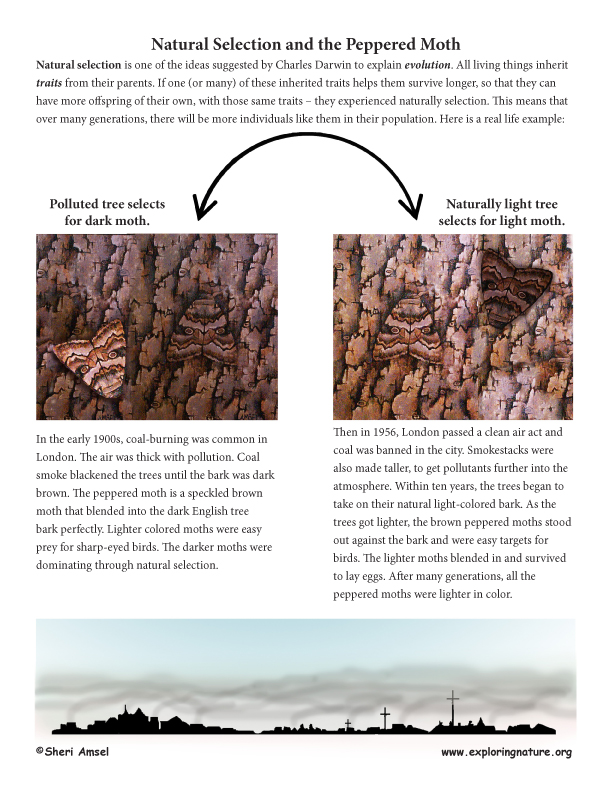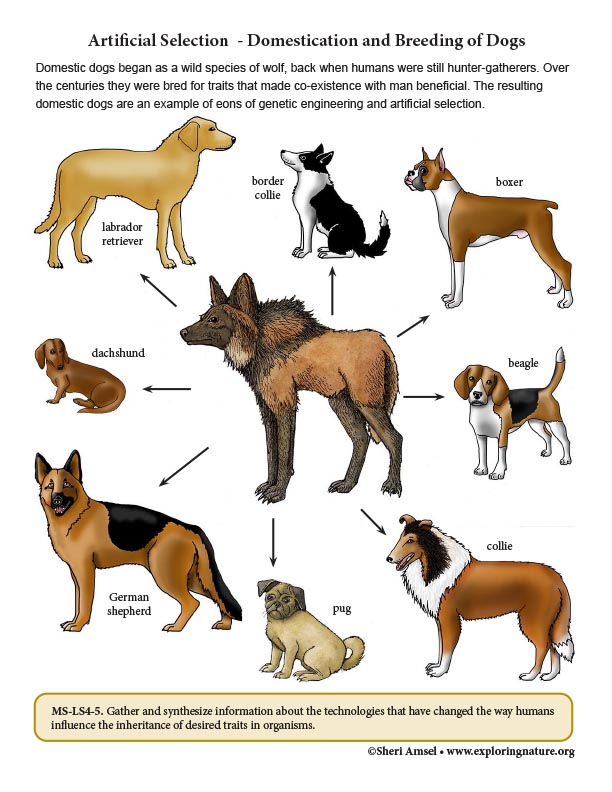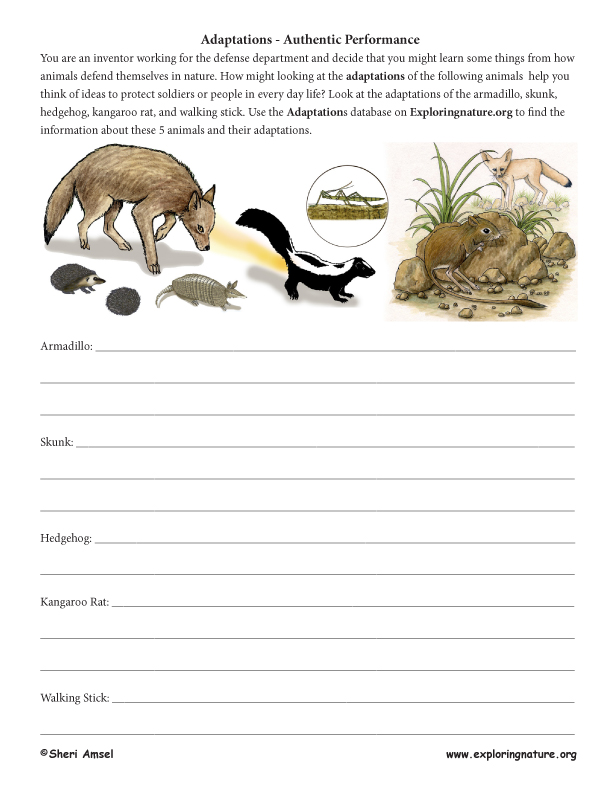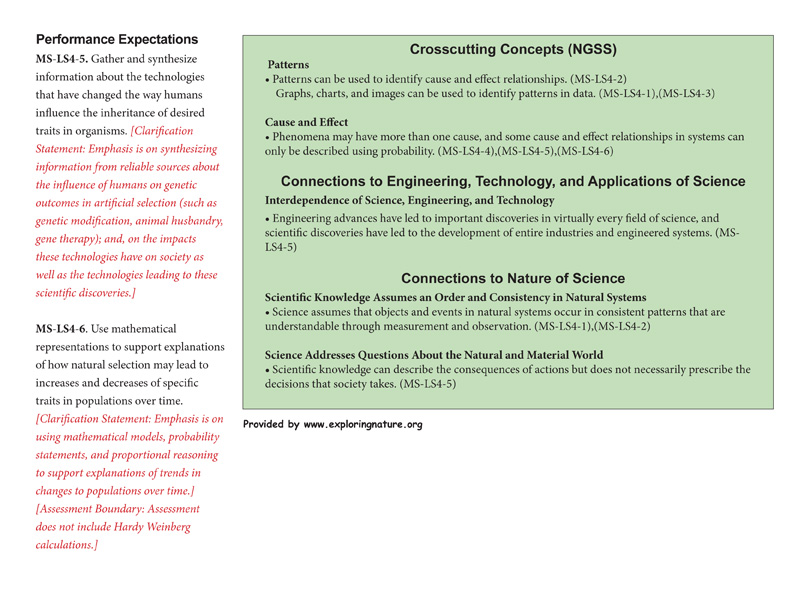

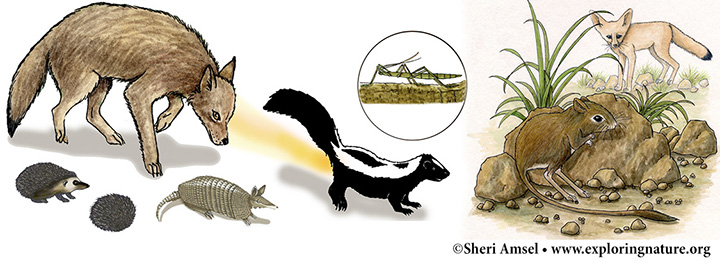
_________________________________________________________________________________________________________________________________________________________
Disciplinary Core Ideas
LS4.B: Natural Selection
• Natural selection leads to the predominance of certain traits in a population, and the suppression of others. (MS-LS4-4)
• In artificial selection, humans have the capacity to influence certain characteristics of organisms by selective breeding. One can choose desired parental traits determined by genes, which are then passed on to offspring. (MS-LS4-5)
LS4.C: Adaptation
• Adaptation by natural selection acting over generations is one important process by which species change over time in response to changes in environmental conditions. Traits that support successful survival and reproduction in the new environment become more common; those that do not become less common. Thus, the distribution of traits in a population changes. (MS-LS4-6)
_________________________________________________________________________________________________________________________________________________________
Use the Template and Resource Links to Fulfill NGSS
l. Goals:
Essential Questions:
NGSS Note: Think, question, entertain ideas.
ll. Introductory Activities to Assess Prior Knowledge
A. Brainstorming Sessions
Question: What are some examples of natural selection in animal coloring?
1. Break students down into groups of 3-4.
2. Ask students to generate a list of the different animals they know that have adaptive coloring.
3. Discuss
Brainstorming Sessions
Question: What are some examples of artificial selection in animal selective breeding?
1. Break students down into groups of 3-4.
2. Ask students to generate a list of the the animals they know of that have been affected by artificial selection.
3. Discuss
lll. New Knowledge - Text
A. Read about:
Adaptation and Natural Selection
Antibiotic Resistance - Reading, Mathematical Modeling, Analysis
Artificial Selection - Domestication of Animals and Plants
Bt Crops - Modern Application of Artificial Selection - Reading
Domestication of Dogs - Artificial Selection - Critical Thinking
Natural Selection and the Peppered Moth Activity
The History of Genetics - How Animals Were Domesticated
The History of Genetics - How Wild Plants Were Domesticated
B. Examples of Models (depicts the concept expressed in the reading):
Ask students to look at the models and explain how each illustrates the concepts they've read about.
lV. Experiments, Activities, Model-making (Critical Thinking)
A. Critical Thinking Activities related to adaptation and natural selection:
Adaptation and Natural Selection Activities
Adaptation and Natural Selection - Short Answer Quiz
Adaptive Traits in Insects - Critical Thinking Activity
Adaptive Traits in Insects - Matching
Camouflage and Adaptive Behaviors - Read, Research, Report
Natural Selection and the Peppered Moth Activity
Natural Selection in Caribou Herds - Critical Thinking Activity
Insect Adaptation - Camouflage Matching
Insect Camouflage Matching - Structure & Function
Adaptation in the Schoolyard - Read and React
Animal Adaptation Observation and Critical Thinking
Insect Camouflage Matching - Structure & Function
Pollination and Seed Dispersal Adaptations
B. Authentic Performance - Understanding by Design (UbD) assessment tool.
Use critical thinking to complete thse Authentic Performance Activities and deepen your understanding about the above topics.
Adaptations - Authentic Performance
Selective Breeding in Llamas - Authentic Performance
V. Summarize Knowledge - Enduring Understandings
Vl. New Generation of Science Standards (NGSS) - Middle School Life Science
Disciplinary Core Ideas
LS4.A: Evidence of Common Ancestry and Diversity
• The collection of fossils and their placement in chronological order (e.g., through the location of the sedimentary layers in which they are found or through radioactive dating) is known as the fossil record. It documents the existence, diversity, extinction, and change of many life forms throughout the history of life on Earth. (MS-LS4-1)
• Anatomical similarities and differences between various organisms living today and between them and organisms in the fossil record, enable the reconstruction of evolutionary history and the inference of lines of evolutionary descent. (MS-LS4-2)
• Comparison of the embryological development of different species also reveals similarities that show relationships not evident in the fully-formed anatomy. (MS-LS4-3)
LS4.B: Natural Selection
• Natural selection leads to the predominance of certain traits in a population, and the suppression of others. (MS-LS4-4)
• In artificial selection, humans have the capacity to influence certain characteristics of organisms by selective breeding. One can choose desired parental traits determined by genes, which are then passed on to offspring. (MS-LS4-5)
LS4.C: Adaptation
• Adaptation by natural selection acting over generations is one important process by which species change over time in response to changes in environmental conditions. Traits that support successful survival and reproduction in the new environment become more common; those that do not become less common. Thus, the distribution of traits in a population changes. (MS-LS4-6)
Science and Engineering Practices
Analyzing and Interpreting Data
Analyzing data in 6–8 builds on K–5 experiences and progresses to extending quantitative analysis to investigations, distinguishing between correlation and causation, and basic statistical techniques of data and error analysis.
• Analyze displays of data to identify linear and nonlinear relationships. (MS-LS4-3)
• Analyze and interpret data to determine similarities and differences in findings. (MS-LS4-1)
Using Mathematics and Computational Thinking
Mathematical and computational thinking in 6–8 builds on K–5 experiences and progresses to identifying patterns in large data sets and using mathematical concepts to support explanations and arguments.
• Use mathematical representations to support scientific conclusions and design solutions. (MS-LS4-6)
Constructing Explanations and Designing Solutions
Constructing explanations and designing solutions in 6–8 builds on K–5 experiences and progresses to include constructing explanations and designing solutions supported by multiple sources of evidence consistent with scientific ideas, principles, and theories.
• Apply scientific ideas to construct an explanation for real-world phenomena, examples, or events. (MS-LS4-2)
• Construct an explanation that includes qualitative or quantitative relationships between variables that describe phenomena. (MS-LS4-4)
Obtaining, Evaluating, and Communicating Information
Obtaining, evaluating, and communicating information in 6–8 builds on K–5 experiences and progresses to evaluating the merit and validity of ideas and methods.
• Gather, read, and synthesize information from multiple appropriate sources and assess the credibility, accuracy, and possible bias of each publication and methods used, and describe how they are supported or not supported by evidence. (MS-LS4-5)
Connections to Nature of Science
Scientific Knowledge is Based on Empirical Evidence
• Science knowledge is based upon logical and conceptual connections between evidence and explanations. (MS-LS4-1)
Crosscutting Concepts (NGSS)
Patterns
• Patterns can be used to identify cause and effect relationships. (MS-LS4-2)
Graphs, charts, and images can be used to identify patterns in data. (MS-LS4-1),(MS-LS4-3)
Cause and Effect
• Phenomena may have more than one cause, and some cause and effect relationships in systems can only be described using probability. (MS-LS4-4),(MS-LS4-5),(MS-LS4-6)
Connections to Engineering, Technology and Applications of Science
Interdependence of Science, Engineering, and Technology
• Engineering advances have led to important discoveries in virtually every field of science, and scientific discoveries have led to the development of entire industries and engineered systems. (MS-LS4-5)
Connections to Nature of Science
Scientific Knowledge Assumes an Order and Consistency in Natural Systems
• Science assumes that objects and events in natural systems occur in consistent patterns that are understandable through measurement and observation. (MS-LS4-1),(MS-LS4-2)
Science Addresses Questions About the Natural and Material World
• Scientific knowledge can describe the consequences of actions but does not necessarily prescribe the decisions that society takes. (MS-LS4-5)
Performance Expectations
Students who demonstrate understanding can:
MS-LS4-1. Analyze and interpret data for patterns in the fossil record that document the existence, diversity, extinction, and change of life forms throughout the history of life on Earth under the assumption that natural laws operate today as in the past. [Clarification Statement: Emphasis is on finding patterns of changes in the level of complexity of anatomical structures in organisms and the chronological order of fossil appearance in the rock layers.] [Assessment Boundary: Assessment does not include the names of individual species or geological eras in the fossil record.]
MS-LS4-2. Apply scientific ideas to construct an explanation for the anatomical similarities and differences among modern organisms and between modern and fossil organisms to infer evolutionary relationships. [Clarification Statement: Emphasis is on explanations of the evolutionary relationships among organisms in terms of similarity or differences of the gross appearance of anatomical structures.]
MS-LS4-3. Analyze displays of pictorial data to compare patterns of similarities in the embryological development across multiple species to identify relationships not evident in the fully formed anatomy. [Clarification Statement: Emphasis is on inferring general patterns of relatedness among embryos of different organisms by comparing the macroscopic appearance of diagrams or pictures.] [Assessment Boundary: Assessment of comparisons is limited to gross appearance of anatomical structures in embryological development.]
MS-LS4-4. Construct an explanation based on evidence that describes how genetic variations of traits in a population increase some individuals’ probability of surviving and reproducing in a specific environment. [Clarification Statement: Emphasis is on using simple probability statements and proportional reasoning to construct explanations.]
MS-LS4-5. Gather and synthesize information about the technologies that have changed the way humans influence the inheritance of desired traits in organisms. [Clarification Statement: Emphasis is on synthesizing information from reliable sources about the influence of humans on genetic outcomes in artificial selection (such as genetic modification, animal husbandry, gene therapy); and, on the impacts these technologies have on society as well as the technologies leading to these scientific discoveries.]
MS-LS4-6. Use mathematical representations to support explanations of how natural selection may lead to increases and decreases of specific traits in populations over time. [Clarification Statement: Emphasis is on using mathematical models, probability statements, and proportional reasoning to support explanations of trends in changes to populations over time.] [Assessment Boundary: Assessment does not include Hardy Weinberg calculations.]
When you research information you must cite the reference. Citing for websites is different from citing from books, magazines and periodicals. The style of citing shown here is from the MLA Style Citations (Modern Language Association).
When citing a WEBSITE the general format is as follows.
Author Last Name, First Name(s). "Title: Subtitle of Part of Web Page, if appropriate." Title: Subtitle: Section of Page if appropriate. Sponsoring/Publishing Agency, If Given. Additional significant descriptive information. Date of Electronic Publication or other Date, such as Last Updated. Day Month Year of access < URL >.
Amsel, Sheri. "LS4.B: Natural Selection and LS4.C: Adaptation (MS-LS4 Biological Evolution: Unity and Diversity)" Exploring Nature Educational Resource ©2005-2024. December 14, 2024
< http://www.exploringnature.org/db/view/1926 >
